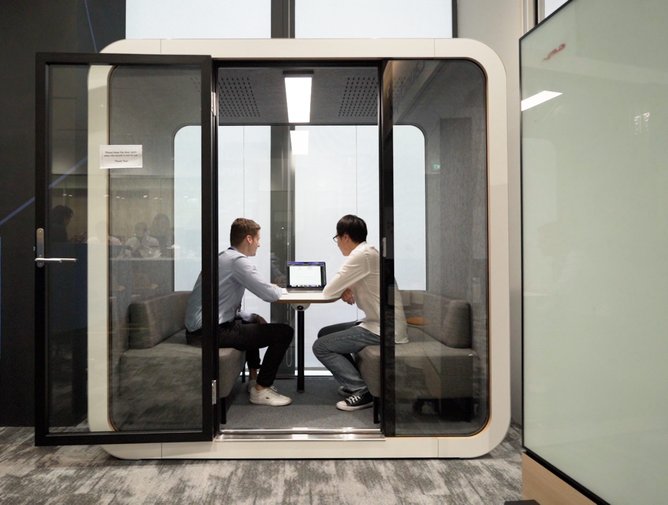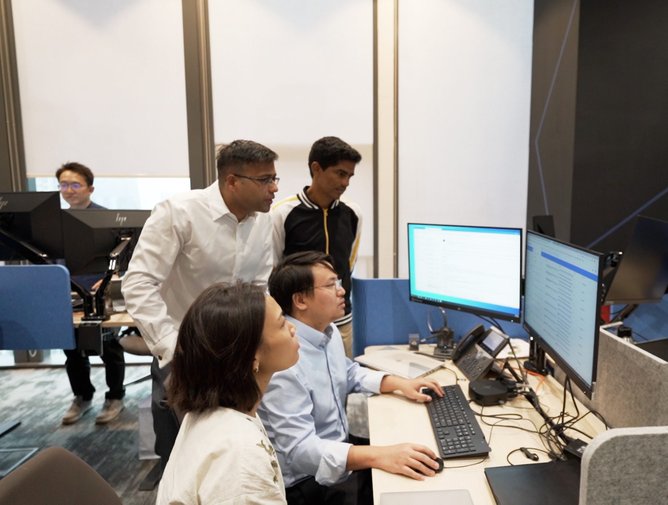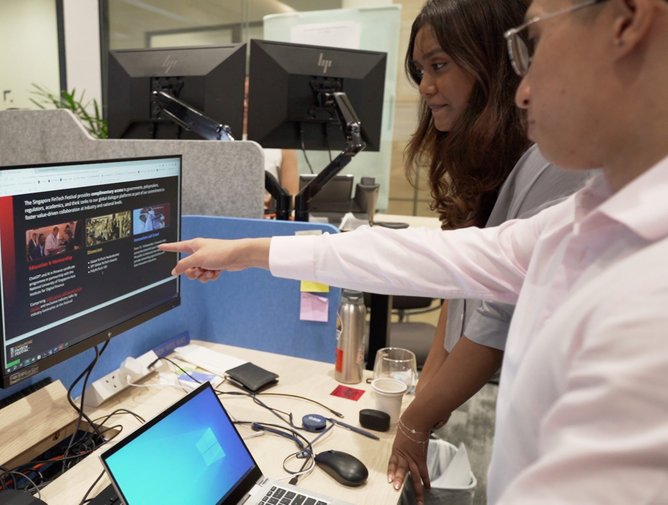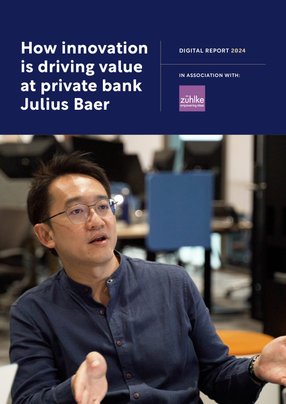How innovation is driving value at private bank Julius Baer
Meet Jonathan Chan, the person driving Global Innovation at Julius Baer
Jonathan Chan is Head of Global Innovation for Julius Baer – a position he has held since June this year, following a two-year stint as Head of Launchpad Asia. A graduate of Singapore Management University, Jon is a seasoned corporate innovation practitioner who recently led transformation and innovation initiatives at insurance company AXA, and agriculture company Cargill.
His appointment is in line with the bank’s broader view of Asia as its second home market and a key source of growth in the last decade.
Innovation in banking is not new; multiple bank innovation labs with bold growth ambitions have come and gone. These lessons are not lost on Chan, who has set up the Global Innovation team to prove that a successful innovation model is still possible in banking.
His team boasts a dedicated full-stack capability, giving them full control of the innovation process, mixed with a blend of experience and youthful hunger. Jon’s team is able to take innovation projects through a pipeline starting from actively scanning opportunities on the horizon with impact on wealth management, to a robust innovation methodology of taking projects through the grind of ideation, validation and incubation which puts the ideas through real-world testing.
Successfully validated products are then transferred to internal business units to run as part of ‘business-as-usual’. The team then resets, focusing on the next set of big opportunities.
Talking to me from his office in Singapore, Jon explains the journey that Julius Baer has been on in recent years to reach this point. “We’ve spent the past 24 months setting up the capability, building the talent pool, creating the portfolio of use-cases as well as the infrastructure for us to move forward. I think the next 12-18 months is going to be the most exciting phase in terms of innovation.
“Now we really get to experiment, move fast, look at new things, look at new areas for exploration. We get to look at how we drive more collaboration globally as a bank and how we explore new technologies at a rapid pace.”
Underlining its commitment to innovation, Julius Baer has made a lot of investments in technology over the past few years. This often gets communicated as ‘moving onto the cloud’, as if it were a catch-all phrase for everything that’s changing within financial services, but Jon believes that this is not the be-all-and-end-all of innovation.
“I wouldn't say that being on the cloud is everything in terms of innovation and transformation,” he tells us. “It's one part of that journey. I think having a hybrid approach is always going to be something that's necessary. And being an open ecosystem, open architecture platform, I think that's something that's going to be quite critical moving forward, especially in this new age of AI.”
How does a private bank incubate new technologies?
The process of originating new innovation is a long and complex one, rich with nuance and speckled with intricate variables that mean no two development projects are the same. It begins with an innovation framework, which initiates every innovation use case at the bank. Jon’s team starts by creating an “opportunity map”, he tells us, which helps identify the key opportunities both inside and out.
His team works with Julius Baer’s leadership to ensure they are aligned from a strategic perspective, but they also work directly with individuals from the bank’s various business units to help pin down some of the common problems that they regularly experience. This drives them forward into the ideation phase, which develops a value proposition distilled from the essence of the problem itself. “We want to start off with a very clear problem statement that we want to try and solve,” Jon says.
This stops the organisation from careering recklessly into creative thinking before they’ve fully understood the initial hurdle – something which, in less structured innovation processes, inevitably leads to a solution that is not fit for purpose, and missing internal alignment – a pre-requisite for scaling innovation projects.
Over the next 2-8 weeks, depending on the scale of the use case, Jon’s team will enter what he calls ‘validation’ – where they confirm that the problem statement they’re solving for is really the problem statement that exists. Ultimately, this will lead to the creation of a clear prototype that meets the stated objectives set at the outset.
“We want to validate the problem statement before we write a single line of code, because the moment we start writing any code, the cost of change goes up quite exponentially,” he explains.
Next comes incubation, which involves the nuts and bolts of building the solution prototype that solves the problem, leading up to alpha and beta tests. “We want to be able to take a prototype and turn that into working software that someone can test in a real-world environment. As a large corporate, that’s a 6-9 month process. It takes a bit of time because we're actually building real, working software.”
Eventually, it becomes time for the business to decide whether or not to move forward with a wider implementation of the solution, marking the end of the “proof-of-concept” phase.
Validation is of vital importance
Once Jon’s team emerges from proof of concept, they are looking to validate the solution within the organisation – but they start relatively small. They enter pre-scale production rather than full enterprise production and begin by validating the product on 18% of the total user base – so if it’s going to be rolled out to 1,000 users eventually, Jon and his team will start by testing it on 180 users. This way, “it's a lot easier for us to cross that chasm when we come to it,” Chan tells us.
I ask him if the fact that Julius Baer is looking after CHF435bn (US$498.2bn) of client assets puts extra pressure on his team to validate before rolling out new solutions – after all, the consequences could potentially be costly if they didn’t follow the process through testing and validation. He replies coolly that every organisation “needs to be conscious” that they’re putting in place the right guardrails ahead of deployment, and engaging in real-world testing before making scale decisions.
“We’ve recently created and launched an innovation sandbox,” he elaborates. “The idea was, we want to be able to engage with and learn from our client's experiences with some of the new products that we're building as quickly as possible.”
“The idea is to test with a pilot group of clients so that we minimise any kind of risk that we might have, while at the same time ensuring all our security requirements are put in place as well for these clients to be able to easily interact with our new solutions, features that can be deployed, either in our mobile applications or on our web applications.
“But being able to rapidly prototype and test with clients and getting real user feedback, I think that's something that we've been very conscious of in terms of how we actually rolled out our sandbox itself.”
He continues: “It's scary as well, right? When you go to pre-scale, even though you validated something in a proof-of-concept with 20 or 30 users, when it goes out to 150 or 200 users you might get completely different results. That's normal in a sense, because when you look at your first handful of users, typically it's always the early adopters. They're already really excited about it. Now you're going to move into the early minority of users, and trying to get them across the line I think is the biggest challenge.
“While it's exciting that we're going there, we are also prepared that, in 12 months from now when we launch our first pre-scale solution, we might actually say ‘we need to kill this’ because people didn’t really want to use it. We weren't able to get critical mass, we weren't able to get 18% of the total addressable user base to actually use it. That’s going to be a huge learning curve, but that being said it would still have saved us a lot of money compared to going into full enterprise-scale production.”
As a long-standing strategic technology and innovation partner to Bank Julius Baer, Zühlke supports the Innovation Lab in co-creating to bring sustainable innovation to market success. By collaborating with ecosystem partners like Zühlke, the bank can now unlock complementary expertise and unique strengths to co-develop next-generation innovations, swiftly test for proofs of concepts and then scale up for market launch.
‘Exploring new opportunities is the reason I do what I do’
During our hour-long discussion, we only begin to scratch the surface of emerging technologies – like AI and blockchain – which are changing the nature of finance, including wealth management and private banking. But nonetheless, I get a real sense of what makes Jon tick, and the passion he has for nurturing real value in the solutions his team conceives.
AI has the power to drive a significant amount of value, efficiency and create new opportunities both for the bank and for the wider industry, he proclaims – particularly if it can help speed up the time taken on ideation or prototyping. Blockchain, likewise, can have a “huge impact on a lot of different things in the financial services space” but, after a volatile couple of years in the crypto market, we have to find a way to decouple crypto from the underlying technology, which is where the real value lies.
“I think change is the thing that excites me the most,” Jon says. “A lot of people ask why I do it in a corporate, rather than building my own startup, but I like to believe that I have a bit of a competitive advantage driving corporate innovation.
“I've been doing it for many years. I've been successful doing it as well across multiple organisations. I like to use my experience, expertise and knowledge to find a way to help drive the next generation of growth for some of these large organisations, or rather the whole transformation of these large organisations.
“I think when we talk about innovation, it's really about how we go down the road of trying new things and really getting outside of our comfort zone. The exploration element is really huge and I love that. I love being able to explore new opportunities and new technologies, and I think for me that is one of the key driving forces behind why I do what I do.”
Make sure you check out the latest edition of Technology Magazine and also sign up to our global conference series - Tech & AI LIVE 2024
**************
Technology Magazine is a BizClik brand






